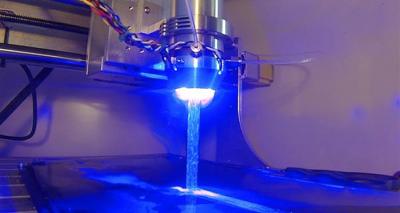Coeur d’Alene, Idaho-based company Continuous Composites has introduced a novel process, known as Continuous Scaled Manufacturing (CSM), that some believe could revolutionize 3D printing. CSM allows Continuous Composites to rapidly 3D print and cure multiple materials at once to form complete, functional parts in real time.
So far, the company has worked with carbon fiber, Kevlar, fiberglass, fiber optics, and continuous copper wire materials using a 3D printing setup with up to 16 different material extruders. According to Continuous Composites founder and inventor Ken Tyler, the combination of continuous fibers and ultraviolet curing is what makes the technology capable of reaching speeds unheard of in 3D printing.
As the continuous curing takes place, the machine reaches speeds of up to 1200 inches per minute – creating freeform and functional components, complete with circuits and wires.
“By combining continuous fibers and rapidly cured proprietary thermoset resins, users are able to print exponentially faster than current industry capabilities,” said Tyler. “In addition, a greater throughput of material results in an overall cubic volume output unrivaled by the traditional appliance approach of 3D printing.”
In addition to speed, Tyler said another benefit of CSM is how little energy the curing process takes.
“This is crucial for applications where power constraints exist,” Tyler said. “Our process also has the ability to integrate fiber optics for real-time analysis of a printed structure as well as printing flexible circuits capable of handling high current and high temperatures, reaching upwards of 300 C.”
Tyler envisions the technology drawing interest from nearly every market that relies on composites.
“Currently we are focused on aerospace and defense markets, as these industries are forward thinking with a lot of resources for R&D,” he said. “Automotive, recreational, marine, medical and construction are other large industries we see our technology having a large impact.”

